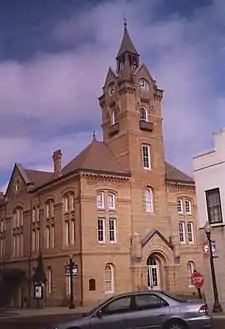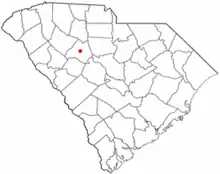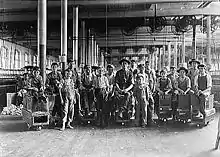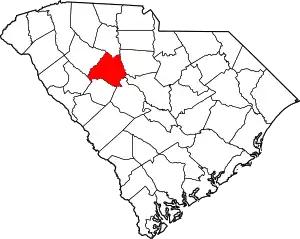Newberry, South Carolina | |
|---|---|
 Newberry Opera House | |
|
Seal | |
| Motto: "The City of Friendly Folks." | |
 Location of Newberry, South Carolina | |
| Coordinates: 34°16′40″N 81°37′00″W / 34.27778°N 81.61667°W | |
| Country | United States |
| State | South Carolina |
| County | Newberry |
| Government | |
| • Mayor | Foster Senn |
| Area | |
| • Total | 9.00 sq mi (23.30 km2) |
| • Land | 8.99 sq mi (23.29 km2) |
| • Water | 0.00 sq mi (0.01 km2) |
| Elevation | 492 ft (150 m) |
| Population | |
| • Total | 10,691 |
| • Density | 1,188.95/sq mi (459.04/km2) |
| Time zone | UTC−5 (Eastern (EST)) |
| • Summer (DST) | UTC−4 (EDT) |
| ZIP code | 29108 |
| Area code(s) | 803, 839 |
| FIPS code | 45-49570 |
| GNIS feature ID | 1249864[2] |
| Website | www.cityofnewberry.com |
Newberry is a city in Newberry County, South Carolina, United States, in the Piedmont 43 miles (69 kilometers) northwest of Columbia. The charter was adopted in 1894. The population was 10,277 at the 2010 census. It is the county seat of Newberry County;[4] at one time it was called Newberry Courthouse.
Newberry became a city in 1976, but did not report the change to the Census Bureau for more than twenty-five years.[5] As a result, the city was listed as a town in the 2000 census.
It is the home of Newberry College, a private liberal-arts college affiliated with the Evangelical Lutheran Church in America.
Geography
Newberry is located at 34°16′40″N 81°37′00″W / 34.277655°N 81.616560°W (34.277655, -81.616560).[6]
According to the United States Census Bureau, the town had a total area of 6.6 square miles (17.0 km2), all land.
Demographics
| Census | Pop. | Note | %± |
|---|---|---|---|
| 1850 | 509 | — | |
| 1870 | 1,891 | — | |
| 1880 | 2,343 | 23.9% | |
| 1890 | 3,020 | 28.9% | |
| 1900 | 4,607 | 52.5% | |
| 1910 | 5,028 | 9.1% | |
| 1920 | 5,894 | 17.2% | |
| 1930 | 7,298 | 23.8% | |
| 1940 | 7,510 | 2.9% | |
| 1950 | 7,546 | 0.5% | |
| 1960 | 8,208 | 8.8% | |
| 1970 | 9,218 | 12.3% | |
| 1980 | 9,866 | 7.0% | |
| 1990 | 10,542 | 6.9% | |
| 2000 | 10,580 | 0.4% | |
| 2010 | 10,277 | −2.9% | |
| 2020 | 10,691 | 4.0% | |
| U.S. Decennial Census[3] | |||
2020 census
| Race | Num. | Perc. |
|---|---|---|
| White (non-Hispanic) | 4,378 | 40.95% |
| Black or African American (non-Hispanic) | 4,529 | 42.36% |
| Native American | 19 | 0.18% |
| Asian | 78 | 0.73% |
| Pacific Islander | 2 | 0.02% |
| Other/Mixed | 373 | 3.49% |
| Hispanic or Latino | 1,312 | 12.27% |
As of the 2020 United States census, there were 10,691 people, 4,047 households, and 2,233 families residing in the city.
2000 census

As of the 2000 census, there were 10,580 people, 3,970 households, and 2,528 families residing in the town. The population density was 1,609.2 inhabitants per square mile (621.3/km2). There were 4,388 housing units at an average density of 667.4 per square mile (257.7/km2). The racial makeup of the town was 52.85% White, 41.36% African American, 0.47% Native American, 0.60% Asian, 0.12% Pacific Islander, 2.88% from other races, and 1.70% from two or more races. Hispanic or Latino of any race were 9.49% of the population.
There were 3,970 households, out of which 29.7% had children under the age of 18 living with them, 36.5% were married couples living together, 22.3% had a female householder with no husband present, and 36.3% were non-families. 31.7% of all households were made up of individuals, and 15.9% had someone living alone who was 65 years of age or older. The average household size was 2.42 and the average family size was 2.97.
In the town the population was spread out, with 23.3% under the age of 18, 14.9% from 18 to 24, 25.5% from 25 to 44, 18.6% from 45 to 64, and 17.6% who were 65 years of age or older. The median age was 34 years. For every 100 females, there were 86.3 males. For every 100 females age 18 and over, there were 81.6 males.
The median income for a household in the town was $27,064, and the median income for a family was $33,490. Males had a median income of $28,681 versus $20,887 for females. The per capita income for the town was $14,389. About 23.8% of families and 28.0% of the population were below the poverty line, including 39.9% of those under age 18 and 21.0% of those age 65 or over.
History


European settlers (primarily German, Scots-Irish, and English) began arriving in great numbers in the 1750s. Newberry County was formed from the Ninety-Six District in 1785. Because of its central location, the town of Newberry was chosen in 1789 as the county seat for Newberry County, which was part of an extensive area of cotton plantations. County and town politics were dominated by planters. By the coming of the railroad in 1851, Newberry had become a thriving trade center. This remained the case until the 1860s.
During the American Civil War, Newberry College was used as a hospital for Confederate and later Union troops. The historic Newberry Court House was not burned by William Tecumseh Sherman's troops as he swept through the South.
Violent racial incidents hit all over the country as part of the 1919 Red Summer. On July 24, 1919 there was the attempted lynching of Elisha Harper of Newberry. Harper was sent to jail for insulting a 14-year-old girl.
The Boundary Street-Newberry Cotton Mills Historic District, Burton House, Caldwell Street Historic District, Coateswood, College Street Historic District, Cousins House, Hannah Rosenwald School, Harrington Street Historic District, Francis B. Higgins House, Main Street Historic District, George Mower House, Newberry College Historic District, Newberry County Memorial Hospital, Newberry Historic District, Newberry Opera House, Oakland Mill, Old Courthouse, Ike Reighley House, Summer Brothers Stores, Timberhouse, Vincent Street Historic District, Wells Japanese Garden, Osborne Wells House, and West Boundary Street Historic District are listed on the National Register of Historic Places.[8][9]
Education
Newberry has a public library, a branch of the Newberry County Library System.[10]
Notable people
- Coleman Livingston Blease (1868–1942), politician of the Democratic Party
- Eugene Satterwhite Blease, former Chief Justice of the South Carolina Supreme Court
- Trevor Booker (b. 1987), former professional NBA player for Washington Wizards
- Lenny Cooper (b. 1988), country rapper
- Carl "CJ" Edwards Jr. (b. 1991), professional baseball pitcher for the Washington Nationals
- Jordan Hill (b. 1987), former professional basketball player for Los Angeles Lakers
- Mickey Livingston (1914–1983), professional baseball catcher for Chicago Cubs
- Billy O'Dell (1933–2018), professional baseball player for San Francisco Giants
- Ralph Rowe (1924–1996), baseball player, manager and coach
- Richard Sligh (1944–2008), professional football player for the Oakland Raiders, tallest player in pro football history
- Henry McNeal Turner (1834–1915), minister, politician, bishop of the African Methodist Episcopal Church (AME), and Georgia state legislator
- Reggie Taylor (b. 1977), professional baseball outfielder
References
- ↑ "ArcGIS REST Services Directory". United States Census Bureau. Retrieved October 15, 2022.
- 1 2 U.S. Geological Survey Geographic Names Information System: Newberry, South Carolina
- 1 2 "Census Population API". United States Census Bureau. Retrieved October 15, 2022.
- ↑ "Find a County". National Association of Counties. Retrieved June 7, 2011.
- ↑ Population Estimates Boundary Changes Archived 2006-02-06 at the Wayback Machine, United States Census Bureau, 2007-07-01. Accessed 2008-11-06.
- ↑ "US Gazetteer files: 2010, 2000, and 1990". United States Census Bureau. February 12, 2011. Retrieved April 23, 2011.
- ↑ "Explore Census Data". data.census.gov. Retrieved December 10, 2021.
- ↑ "National Register Information System". National Register of Historic Places. National Park Service. July 9, 2010.
- ↑ "National Register of Historic Places Listings". Weekly List of Actions Taken on Properties: 6/13/11 through 6/17/11. National Park Service. June 24, 2011.
- ↑ "Locations & Hours". Greenville County Library System. Retrieved June 13, 2019.
External links
- City of Newberry
- The Newberry Observer
- Newberry Oktoberfest
- Visit Newberry, SC
- Newberry College
- Newberry Historical and Museum Society Archived 2009-08-26 at the Wayback Machine
- Newberry Opera House
- The Ritz Theater
 Texts on Wikisource:
Texts on Wikisource:
- "Newberry". Collier's New Encyclopedia. 1921.
- "Newberry". Encyclopedia Americana. 1920.
- "Newberry". New International Encyclopedia. 1905.
